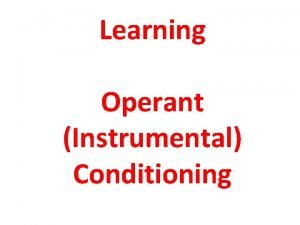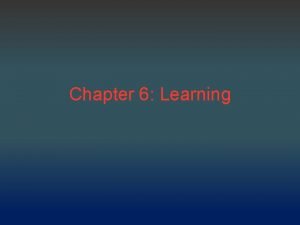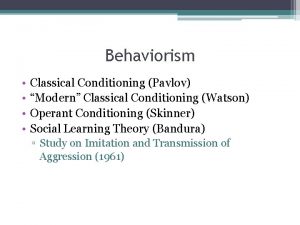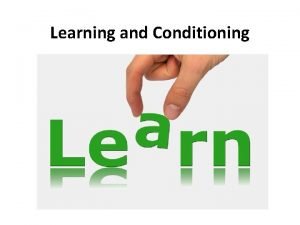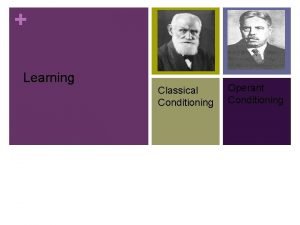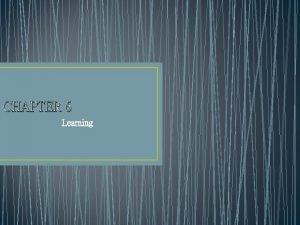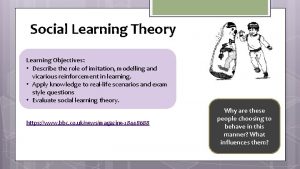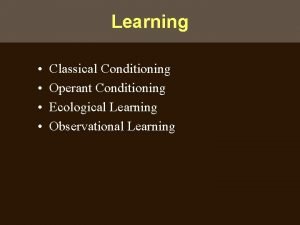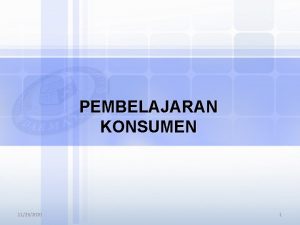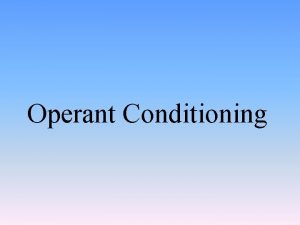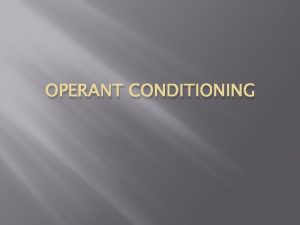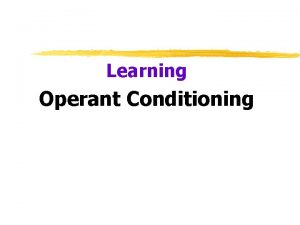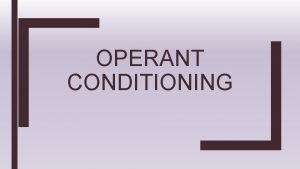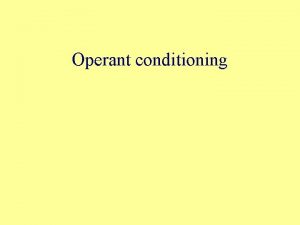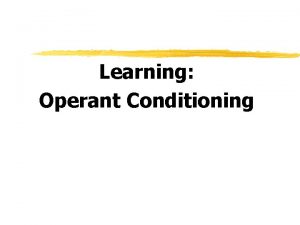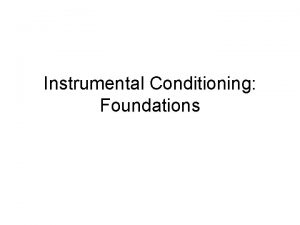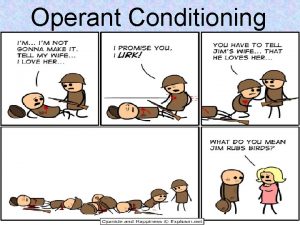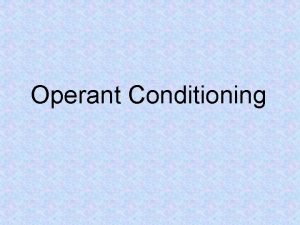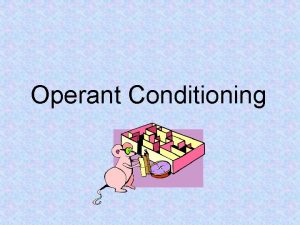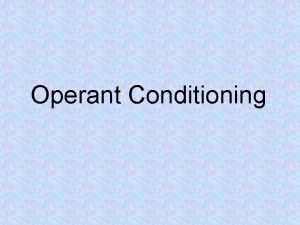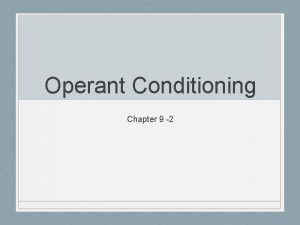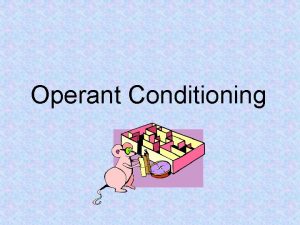Learning Operant Instrumental Conditioning Operant Conditioning Operant Conditioning

















- Slides: 17

Learning Operant (Instrumental) Conditioning

Operant Conditioning • Operant Conditioning – Also called instrumental conditioning; a form of learning that pertains to response-outcome relationships. • Unlike classical (Pavlovian) conditioning, operant conditioning emphasizes responses from the somatic nervous system. – The responses “operate” on the environment, usually to bring about a change suitable to the organism.

Thorndike & Law of Effect • The Law of Effect – Behavior is modified by its consequences. http: //en. wikipedia. org/wiki/Law_of_effect Thorndike’s Puzzle Box http: //en. wikipedia. org/wiki/File: Puzzle_box. jpg

Skinner & Logical Positivism • Logical Positivism – A philosophical approach that relies entirely on testable claims. – Logical positivists are known for their inferential caution – They err on the side of Type 2 errors • They might be guilty of “reading too little into the data” • They rarely “read too much into the data” • They are more likely to “Miss” than to “False Alarm” • L. P. s make a strong distinction between the following – “The participant responded to the stimulus” (requires no inference) • L. P. s like such statements – “The stimulus elicited the response” (assigns causal power to stimulus) • L. P. s avoid such statements • Opposition to mentalistic claims, or internal states – L. P. s avoid stating what organisms “know”, “think”, “expect”, “believe”, “want”, “like”, “dislike”, etc.

Skinner & Logical Positivism • L. P. s rely heavily on operational definitions – Stating the procedures (“operations”) used to measure a variable • Examples of Operational Definitions – Attention – The selection of sensory events • L. P. ’s refer to the “cued stimulus” rather than to the “attended stimulus”. Why? – Motivation - # of hours of food deprivation • L. P. ’s avoid referring to “hungry” or “thirsty”. Why?

Other Logical Positivists • Bertrand Russell – – Russell’s Teapot – “if he were to assert, without offering evidence, that a teapot orbits the Sun somewhere in space between the Earth and Mars, he could not expect anyone to believe him solely because his assertion could not be disconfirmed. ” • https: //en. wikipedia. org/wiki/Russell%27 s_teapot – Assign the burden of evidence to those who make a claim, rather than assigning the burden of disconfirmation to others.

Other Logical Positivists • Christopher Hitchens – – Hitchens Razor • “What can be asserted without evidence can be dismissed without evidence. ” – Latin Proverb • “Quod gratis asseritur, gratis negatur” – "What is freely asserted is freely dismissed“

Skinner & Operant Behavior • Operants – emitted behavior • Discriminitive Stimulus - a stimulus, associated with reinforcement, that exerts control over a behavior; SD http: //en. wiktionary. org/wiki/discriminative_stimulus

Shaping • Shaping – a conditioning procedure that relies on differential reinforcement of successive approximations. • Critical Thinking Question – How is “shaping” similar to the process of evolution? – How is it different?

Behavioral Contrast • Behavioral Contrast – “a change in the strength of one response that occurs when the rate of reward of a second response, or of the first response under different conditions, is changed. ” • http: //en. wikipedia. org/wiki/Behavioral_contrast • Example: – “Rat X” initially receives 5 pellets per response – “Rat Y” initially receives 9 pellets per response – If each rat subsequently receives 7 pellets per response, Rat X’s response rate increases while Rat Y’s response rate decreases. • Informal comments about “sense of entitlement”?

Reinforcers • Primary Reinforcers – Examples: food, water, sex, escape • Conditioned (Learned) Reinforcers – Examples: money, a wink of an eye • Some scientists argue that reinforcers can be defined only “post hoc” (after the fact) i. e. , after determining whether the behavioral response rate increased….

http: //en. wikipedia. org/wiki/File: Operant_conditioning_diagram. png

Schedules of Reinforcement • Continuous Reinforcement – A “reward” is earned after each desired response. – Continuously reinforced responses are vulnerable to extinction • Partial Reinforcement – A “reward” is earned only after multiple desired responses. – Partially reinforced behaviors are resistant to extinction (Ex. gambling)

Fixed Reinforcement Schedules • Fixed Ratio Schedule – (FR) reinforcement occurs after a set number of responses. – Ex: FR 2 reinforcement after every 2 responses – Ex: “Buy 2 soft drinks, get the third one free” • Fixed Interval Schedule – (FI) reinforcement of the first response after a set time duration. – Ex: FI 300 reinforcement of 1 st response after 300 seconds (i. e. , 5 minutes) – Ex: Mom rewards requests for attention only on the 1 st request after 5 minutes. (Other requests ignored. )

Variable Reinforcement Schedules • Variable Ratio Schedule – (VR) reinforcement occurs after an AVERAGE # of responses. – Ex: VR 200 reinforcement after every 200 responses on average. – Ex: A telephone sales person needs to make 200 calls on average before making a sale. • Variable Interval Schedule – (VI) reinforcement of the first response after an average duration. – Ex: VI 1, 800 reinforcement of 1 st response after 1, 800 seconds (i. e. , 30 minutes) on average. – Ex: Email checking is rewarded, on average, every 30 minutes. (More frequent responses yield no reinforcement. )

http: //en. wikipedia. org/wiki/File: Schedule_of_reinforcement. png Hash Marks Indicate Reinforcement Potential Pop Quiz Question – Why do the response rates slow immediately after reinforcement on fixed schedules (F) but not variable schedules (V)?

 Operant vs classical
Operant vs classical Fixed ratio graph
Fixed ratio graph Operant vs. classical conditioning
Operant vs. classical conditioning Little albert classical conditioning
Little albert classical conditioning Tolmans rat experiment
Tolmans rat experiment Operant vs classical
Operant vs classical Classical conditioning examples
Classical conditioning examples Secondary reinforcers
Secondary reinforcers Operant vs classical conditioning
Operant vs classical conditioning Classical conditioning vs operant conditioning
Classical conditioning vs operant conditioning Operant conditioning classical conditioning
Operant conditioning classical conditioning Types of reinforcement schedules
Types of reinforcement schedules Instrumental learning vs classical conditioning
Instrumental learning vs classical conditioning Evaluate social learning theory
Evaluate social learning theory Albert bandura operant conditioning
Albert bandura operant conditioning Real life example of classical conditioning
Real life example of classical conditioning Instrumental conditioning in marketing
Instrumental conditioning in marketing Home youtube
Home youtube

